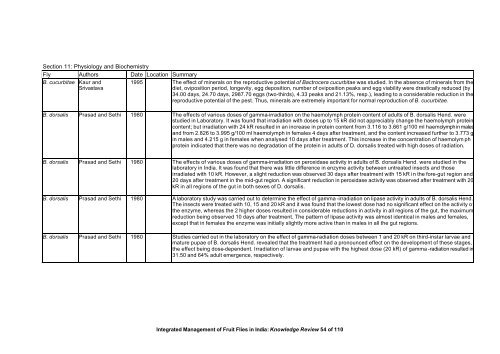“Key Informant Survey” of Production, Value, Losses and ... - DfID
“Key Informant Survey” of Production, Value, Losses and ... - DfID
“Key Informant Survey” of Production, Value, Losses and ... - DfID
You also want an ePaper? Increase the reach of your titles
YUMPU automatically turns print PDFs into web optimized ePapers that Google loves.
Section 11: Physiology <strong>and</strong> Biochemistry<br />
Fly Authors Date Location Summary<br />
B. cucurbitae Kaur <strong>and</strong> 1995 The effect <strong>of</strong> minerals on the reproductive potential <strong>of</strong> Bactrocera cucurbitae was studied. In the absence <strong>of</strong> minerals from the<br />
Srivastava<br />
diet, oviposition period, longevity, egg deposition, number <strong>of</strong> oviposition peaks <strong>and</strong> egg viability were drastically reduced (by<br />
34.00 days, 24.70 days, 2987.70 eggs (two-thirds), 4.33 peaks <strong>and</strong> 21.13%, resp.), leading to a considerable reduction in the<br />
reproductive potential <strong>of</strong> the pest. Thus, minerals are extremely important for normal reproduction <strong>of</strong> B. cucurbitae.<br />
B. dorsalis Prasad <strong>and</strong> Sethi 1980 The effects <strong>of</strong> various doses <strong>of</strong> gamma-irradiation on the haemolymph protein content <strong>of</strong> adults <strong>of</strong> B. dorsalis Hend. were<br />
studied in Laboratory. It was found that irradiation with doses up to 15 kR did not appreciably change the haemolymph protein<br />
content; but irradiation with 24 kR resulted in an increase in protein content from 3.116 to 3.661 g/100 ml haemolymph in males<br />
<strong>and</strong> from 2.826 to 3.995 g/100 ml haemolymph in females 4 days after treatment, <strong>and</strong> the content increased further to 3.773 g<br />
in males <strong>and</strong> 4.215 g in females when analysed 10 days after treatment. This increase in the concentration <strong>of</strong> haemolym ph<br />
protein indicated that there was no degradation <strong>of</strong> the protein in adults <strong>of</strong> D. dorsalis treated with high doses <strong>of</strong> radiation.<br />
B. dorsalis Prasad <strong>and</strong> Sethi 1980 The effects <strong>of</strong> various doses <strong>of</strong> gamma-irradiation on peroxidase activity in adults <strong>of</strong> B. dorsalis Hend. were studied in the<br />
laboratory in India. It was found that there was little difference in enzyme activity between untreated insects <strong>and</strong> those<br />
irradiated with 10 kR. However, a slight reduction was observed 30 days after treatment with 15 kR in the fore-gut region <strong>and</strong><br />
20 days after treatment in the mid-gut region. A significant reduction in peroxidase activity was observed after treatment with 20<br />
kR in all regions <strong>of</strong> the gut in both sexes <strong>of</strong> D. dorsalis.<br />
B. dorsalis Prasad <strong>and</strong> Sethi 1980 A laboratory study was carried out to determine the effect <strong>of</strong> gamma -irradiation on lipase activity in adults <strong>of</strong> B. dorsalis Hend.<br />
The insects were treated with 10, 15 <strong>and</strong> 20 kR <strong>and</strong> it was found that the lowest dose had no significant effect on the activity <strong>of</strong><br />
the enzyme, whereas the 2 higher doses resulted in considerable reductions in activity in all regions <strong>of</strong> the gut, the maximum<br />
reduction being observed 10 days after treatment. The pattern <strong>of</strong> lipase activity was almost identical in males <strong>and</strong> females,<br />
except that in females the enzyme was initially slightly more active than in males in all the gut regions.<br />
B. dorsalis Prasad <strong>and</strong> Sethi 1980 Studies carried out in the laboratory on the effect <strong>of</strong> gamma-radiation doses between 1 <strong>and</strong> 20 kR on third-instar larvae <strong>and</strong><br />
mature pupae <strong>of</strong> B. dorsalis Hend. revealed that the treatment had a pronounced effect on the development <strong>of</strong> these stages,<br />
the effect being dose-dependent. Irradiation <strong>of</strong> larvae <strong>and</strong> pupae with the highest dose (20 kR) <strong>of</strong> gamma -radiation resulted in<br />
31.50 <strong>and</strong> 64% adult emergence, respectively.<br />
Integrated Management <strong>of</strong> Fruit Flies in India: Knowledge Review 54 <strong>of</strong> 110

















